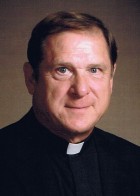Recognizing God’s love and mercy in the body of Christ – the Church

Father R. Michael Schaab
Easter Sunday of the Resurrection of the Lord/March 27
Acts 10:34a,37-43; Psalm 118:1-2,16-17,22-23; Colossians 3:1-4 or 1 Corinthians 5:6b-8; Sequence: Victimae Paschali Laudes; John 20:1-9
The Church designates the great Feast of Easter as an octave, or eight-day celebration. This means that Easter itself is celebrated as an eight-day-long feast. Every day of the octave is Easter.
One indication of this is found in the dismissal from Masses during the octave. The wording used is, “Go in peace. Alleluia, Alleluia.” Only on these eight days, and on Pentecost Sunday, which concludes the 50-day Easter Season, is Mass concluded with the double “Alleluia.”
Quite simply, we believe in the Resurrection because, through the eyes of faith, we recognize the risen Christ in his new body — in the Church.
So, to really understand the Scriptures of Easter we have to look at all the biblical readings from Easter Sunday through the six days of Easter Week, up to and including the Second Sunday of Easter, Divine Mercy Sunday. Let us focus on the Gospel texts for these eight days.
The underlying theme for the octave Gospels is belief in the Resurrection. For the early Church this was a burning issue. How could a person really know that Jesus Christ had conquered death without actually seeing Christ alive after the Resurrection? As Christianity spread throughout the ancient world, it would require belief in the Resurrection from people who had never seen the risen Lord. That’s why the Resurrection was, and is, so important.
SEEING WITH EYES OF FAITH
This year the Easter Sunday Gospel is John 20:1-9. Mary Magdalene has been to the empty tomb. She reports this to the Eleven Apostles, and Peter and John then run to the tomb to see for themselves. Only John, the disciple Jesus loved, is presented in the Gospel as believing in the Resurrection: “Then the other disciple (John) who had reached the tomb first also went in; he saw and he believed.” He believed because he saw with the eyes of faith. This is the model of faith that is held up for us.
The Gospels of Easter Week, taken from all four Evangelists, are devoted to the many appearances of Jesus after the Resurrection to those who had the privilege of seeing the risen Christ. Then comes the great Gospel (John 20:19-31) on the Second Sunday of Easter, Divine Mercy Sunday, the last day of the octave. It has two parts — the commissioning of the disciples and the story of “doubting Thomas.”
Thomas represents the Church, all those generations down through history who will be called to believe in the Resurrection but who have not seen the risen Christ. Thomas is told by Christ, “Blessed are those who have not seen and yet believe.” Those words are addressed to us, also.
But we are still left with the question, “Why?” Why should we believe in the Resurrection, in the risen Christ, when we have not had the privilege of seeing the risen Christ? Why are we blessed when we believe even though we have not seen? The answer is found in the first part of the Gospel for the last day of the octave.
EMBODIMENT OF MERCY
Jesus came into the world as the embodiment of God’s mercy. At the Jordan he was filled with the Holy Spirit so he could preach the Good News of redemption. He was the Word made Flesh so he put into action the mercy he preached. He forgave sin, healed the lame, cured the sick, restored sight to the blind, fed the hungry and cleansed the leper, and even raised the dead to life. Now Christ commissions the disciples by giving them the same Holy Spirit which will enable them also to preach the Good News and to do everything that Jesus did. They are now called to receive Divine Mercy and to embody it throughout the world.
In the end, through the power of the Holy Spirit and the action of Divine Mercy, the Church provides an answer to the question, “Why should we believe without seeing?” We believe because we recognize God’s love and mercy in the Church as it was in Jesus.
We hear the proclamation of God’s love and mercy in the words of the Church as we did in the preaching of Jesus. We see the effects of God’s love and mercy in the actions of the Church just as we saw them in the works of Jesus.
Quite simply, we believe in the Resurrection because, through the eyes of faith, we recognize the risen Christ in his new body — in the Church.
—–
FATHER R. MICHAEL Schaab is a senior priest of the Diocese of Peoria who gives retreats and days of recollection, and who fills in as presider at parish Masses on weekends. He resides on a hobby farm in Putnam County.





